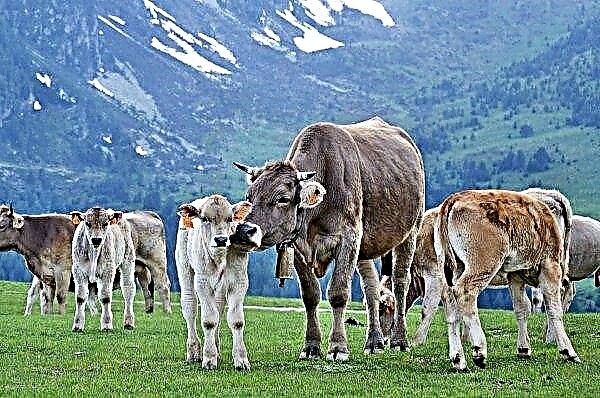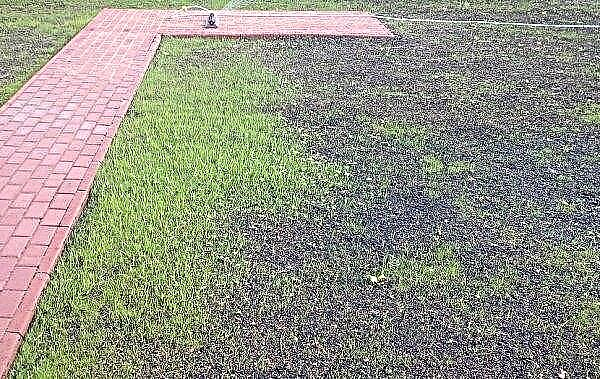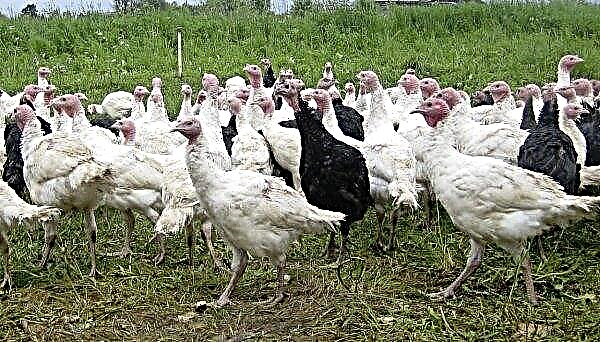When deciding to equip an apiary on your homestead plot, you need to know about the basic rules of apiary farming, including the principles of breeding and keeping bee colonies in settlements. The article will describe in detail the rules and recommendations for protecting the rights of beekeepers, as well as neighbors living near the apiary.
Did you know? To get 1 tablespoon of honey, a bee swarm of two hundred insects must work hard for a whole day.
The norms of keeping bees in settlements
Licensing is not provided for beekeeping, nor does it require any special permits to organize this type of agricultural activity. But still there are certain rules for keeping bees within the boundaries of settlements.
The beekeeper in his activity should be guided by the following standards:
- The location of the apiary should be 0.5 km from highways and railways; 5 km to the gustatory and confectionery industries and chemical plants; 1 km from a poultry complex, stables or livestock farm; 100 meters from the border with a kindergarten, school, hospital.
- State bodies, guided by law, strictly regulate the permissible number of bee colonies that can be kept in an apiary.
- For breeding bees, a passport is required, which indicates how many families placed on a particular site, it is permissible to keep. On average, one family needs a land plot of at least 35 m².
- Mandatory measures to prevent the swarming of bees, which can provoke a massive attack of insects and causing harm to others.
- The rules for beekeeping indicate that the breeder is legally liable if his bees cause damage to the property or health of those around him or to pets.
- Keeping bees in safe conditions and monitoring their health is mandatory, since you should not wait for honey products from sick pets. It is necessary to feed insects with syrup and honey, as well as provide them with fresh drink in the form of clean water.
- Bee families need to be transported according to certain rules specified below.

Fundamental rules
There are a number of basic territorial and veterinary sanitary rules for breeding bees within the boundaries of settlements related to the placement of hives, regulating the number of bee colonies, the rules of transportation, caring for insects.
Important! Starting to beekeeping, you need to consult whether there are internal acts in your locality or special requirements and rules for the maintenance of bees, since such documents, adopted at the local level, can additionally limit the number of bee colonies placed on sites.
Hive placement
The location requirements for bee houses on the site are as follows:
- Beehives are located 10 m from each boundary of the plot along the perimeter. With a small area, their placement at a height of 2 and more meters is allowed. Another alternative is a fence or structure that is adjacent to the neighbors' area, which exceeds 2 m in height. In this case, the placement of hives is allowed directly at the fence or in the middle of the yard.
- On the site, it is permissible to put the houses one from another at a distance no closer than 3 m. If the houses are multi-row, they are placed 3 m from the neighboring one, and 10 m from the next row (no more than 0.01 ha of land 6 bee dwellings).
- Letters in the hives should be directed towards the middle of the apiary, and not outward to neighboring areas.
- The entire perimeter of the apiary is enclosed by a solid fence, or a dense fence of green spaces (at least 2 m in height). This is necessary so that the bees, leaving the site in search of nectar, immediately fly up, without touching outsiders.
- Even before the formation of their own apiary, it is necessary to conduct a survey of the owners of sites bordering yours on their allergic reactions to a bee sting. If this is not done, complaints may be filed against beekeeping, after which an inspection will be sent to the relevant authorities and you will be fined for not observing the rules for keeping bees in the residential sector.

Number of bee colonies
Local government in each locality regulates the content of the permissible number of bees by one breeder. Typically, a single bee family needs 30–35 m² of land.
Did you know? During the honey harvest season, one bee is able to fly a distance approximately equal to the distance between the Earth and the Moon.
Bee Swarm Prevention
In order not to endanger others from being attacked by angry insects, beekeepers should take measures to prevent their swarming:
- A week or two before the expected harvest of the sweet harvest, the bees need to increase the load by adding several additional frames with wax to the hives, or by building several additional hives.
- Make layering with the fetal uterus and add a few more frames to the hive.
- If the age of the uterus exceeds three to four years, it is replaced with a new one, since in hives with one-year-old (or somewhat older) young uterus, swarming does not occur.
- If there is constant hot weather, the hive needs to be shaded (sometimes swarming is caused by excessive heat).
- You can increase bee honey collection by planting melliferous plants blooming at different times on the yard, and then use these herbs for haying.

Responsibility for Bees
Since the bee swarms are the property of the beekeeper, he will be liable for the damage that the bees gathered in the swarm can cause to neighbors. Subject to damage by a landfill swarm consisting of insects from several owners, compensation for damage in equal parts will be distributed among all breeders. It is important to understand that if you follow all the rules for keeping bee colonies within the city, and timely form layering, insects will not attack neighboring residents and will not fly to other people's sites.
Important! Beekeeper beginners are advised to purchase bee colonies after consulting zonal or regional beekeeping stations, public apiaries or state beekeepers where professionals select them. This will help to avoid buying an old, unproductive or sick bee population.
Provided the swarm is lost, the owner has the right to pursue it and get it back (only under the condition of continuous pursuit of the swarm, in which insects have chosen a strange, unoccupied hive). If the swarm settled in a strange residential hive, the owner of the escaped bee colony has a legal right to compensation. If the injured beekeeper refuses to prosecute the lost property, his swarm is considered neglected.
Maintaining a sanitary and veterinary passport
All beekeepers must have a veterinary and sanitary passport, otherwise his bee business will be outlawed. This document is filled in by the veterinary service, which inspects the hives and makes appropriate notes. The presence of this document is necessary for conducting business (selling honey, wax, bee venom), as well as for acquiring bee products.
Beekeeper Logging
Breeders are also strongly encouraged to keep a beekeeping journal and beekeeper diary. This documentation is necessary for the breeders themselves, since it will be easier for them to analyze what circumstances and conditions contribute to obtaining better honey, what is the development of bee colonies, and what factors influence them (these books are kept in any form).
Below is an example of one of the forms of such a journal:
| Date Inspection | Strength of the seven in the streets | Remained in the nest after inspection | Danish Wax | Notes | ||
| framework (total) | including ramox brood | honey (kg) | ||||
What breeds of bees are suitable?
In the absence of personal apiaries outside the city, in the urban area, keeping peace-loving bees with high productivity is recommended (their maintenance is less troublesome and they swarm less).
You can breed bee breeds:
Bee Carriage
Bee colonies transport according to certain rules:
- Since hives will shake during transportation, this can trigger insects to become angry and angry. Therefore, the ride should be neat, carried out on cool night hours (it is better in September, so you will avoid overheating of insects), and stop only in a pinch, and no more than 15 minutes.
- The hives for transportation are placed on a bed of straw, in a two-tier order, after which they are bandaged crosswise to avoid falling. Between them observe a distance of 10 cm.
- Transportation of families depends on whether or not the flight occurred. If this process has already taken place, the hives are moved to a distance of more than 2 km from the old hive site. If not, they can be transported at a closer distance. This is due to the fact that if the bees have already flown around, there is a risk of them returning to the old site.
Proper care
There are principles for caring for bees that prevent their diseases:
- In the middle of spring, it is necessary to conduct a spring audit of the apiary on the farmstead courtyards: at this time, the honeycombs are inspected and replaced, and the nests are moved to clean houses.
- In the last decade of May, a bee veterinarian check for diseases is carried out. At this time, the uterus is evaluated by brood and a printed brood is selected for layering. They also shuffle houses and expand nesting sites.
- At the beginning of summer, the nests are expanded by adding several pairs of honeycombs (6–12), the honey is pumped out and the printed brood is selected (to combat swarming). Honey is pumped out to clean the honeycombs before the main honey collection. During a routine examination, weak uterus and bee colonies are rejected.
- In early August, the period of nest formation begins after honey collection and the preparation of a framework with a sweet crop for its pumping. If necessary, remove the extra housing. At the end of the last month of summer, an audit is made of the content of bee colonies and the assembly of nesting sites before wintering. All strong families leave on 12 frames.
- In the fall, inspect the apiary and, if necessary, transplant bees. After they are fed sugar syrup. In a warm climate, toilers are fed up to November, in a cold climate - until the end of August. It is important to understand that these procedures not only allow you to send the bees to winter, but also properly prepare the insects for this period of the year.

How to protect your rights?
In addition to the rights that the owner of the apiary has, their neighbors also have rights. If a beekeeper’s neighbor in the private sector has a couple of beehives, he must understand that he must properly plan the lives of his pets so that their individual representatives do not bother people living in the nearby territory. It happens that individual beekeepers, in pursuit of profit, violate the norms, standards and rules of keeping bee families, thereby ignoring the comfortable living of neighbors. If this state of affairs is observed, it is necessary to safely take measures.
Here are some guidelines for doing the right thing while protecting your rights:
- In a polite manner, you need to explain to the beekeeper neighbor about his violation of the laws and rules for keeping bees, and if possible, advise him on how to best equip the apiary so as not to have claims against each other.
- The location of the beehives at the neighbor’s site should be checked before the flowering of trees and shrubs, since with the onset of persistent heat it will be too late to rectify the situation.
- You can purchase a protective uniform (for example, a hat with mesh protection), as well as stock up on antihistamines (after consultation with your doctor).
- Access to your site can be closed with a fine mesh.
- Check with the neighboring owner of the bee farm at what time gardening events will be held so that you can not intersect with each other during this period.
- You must notify the beekeeper’s neighbor of your relatives, children, or acquaintances visiting you so that he does not work in the apiary at this time.
- If the owner of the beekeeping adjacent to you does not respond adequately to your polite comments, you need to record on the video or photo the cases when the bees inflicted bites. It is also permissible to collect medical certificates, testimonies of neighbors in your village or in a garden partnership, united in the defense of their rights.
- When collective complaints are received, state institutions will respond faster to them, and in court they will issue a verdict, taking into account the interests of the majority.
- You can record cases of serious violation of the rules for keeping bees.
- Remember that destroying other people's property (bees) is not permissible, since such actions are criminal, prosecuted by the Criminal Code.

How to avoid conflicts?
It is important to understand that even observing all the rules for keeping bees in a village, breeders run the risk of good neighborly relations with residents of the neighborhood, as some people may have an allergic reaction to a bee sting. In order to comply with the law, as well as to avoid conflicts on this basis, you first need to think not only about your interests, but also about your neighbors.
Your actions:
- First of all, neighbors need to be warned about your intentions to do amateur beekeeping.
- It is also important to constantly monitor compliance with the temperature regime, as well as the free access of bees to fresh and clean water.
- An important nuance will be the correct location in the country or adjacent to the house plot of bee houses.
These measures will ensure a quiet stay for neighbors, since winged pets simply do not need to fly to them. But only the bees will start to freeze or overheat, as well as to thirst that they cannot quench on your territory, then all the neighbors who have these conditions will be affected.
In conclusion, we emphasize that the owners of “winged toilers” are doing an important job, producing a valuable food product - honey. But at the same time, they should not forget that peaceful neighborly relations and respect for someone else's private life also matter.












